ISSN ONLINE(2278-8875) PRINT (2320-3765)
ISSN ONLINE(2278-8875) PRINT (2320-3765)
| K. B. Mohd. Umar Ansari1 PG Student [EPES], Dept. of EEE, AKG Engineering College, Ghaziabad, Uttar Pradesh, India1 |
| Related article at Pubmed, Scholar Google |
Visit for more related articles at International Journal of Advanced Research in Electrical, Electronics and Instrumentation Engineering
When integrated to the power system, large wind farms pose stability and control issues. A thorough study is needed to identify the potential problems and to develop measures to mitigate them. Although integration of high levels of wind power into an existing transmission system does not require a major redesign, it necessitates additional control and compensating equipment to enable recovery from severe system disturbances. This paper investigates the use of a Static Synchronous Compensator (STATCOM) along with wind farms for the purpose of stabilizing the grid voltage after grid-side disturbances such as a three phase short circuit fault, temporary trip of a wind turbine and sudden load changes. The strategy focuses on a fundamental grid operational requirement to maintain proper voltages at the point of common coupling by regulating voltage. The DC voltage at individual wind turbine (WT) inverters is also stabilized to facilitate continuous operation of wind turbines during disturbances.
Keywords |
| STATCOM, Bus bar, Wind turbines, Wind Generation, Transient Stability. |
INTRODUCTION |
| Now a day’s wind as a significant proportion of non pollutant energy generation is widely used. The wind farm capacity is being continuously increased through the installation of more and larger wind turbines. Voltage stability and an efficient fault ride through capability are the basic requirements for higher penetration. Wind turbines have to be able to continue uninterrupted operation under transient voltage conditions. |
| One of the major issues concerning a wind farm interconnection to a power grid concerns its dynamic stability on the power system. Voltage instability problems occur in a power system that is not able to meet the reactive power demand during faults and heavy loading conditions. A wind farm is usually spread over a wide area and has many wind generators, which produce different amounts of power as they are exposed to different wind patterns. |
| Flexible AC Transmission Systems (FACTS) such as the Static Synchronous Compensator (STATCOM) and the Unified Power Flow Controller (UPFC) are being used extensively in power systems because of their ability to provide flexible power flow control. The main motivation for choosing STATCOM in wind farms is its ability to provide bus bar system voltage support either by supplying and/or absorbing reactive power into the system. |
| In this paper, a STATCOM is added to the power network to provide dynamic voltage control for the wind farm, dynamic power flow control for the transmission lines, relieve transmission congestion and improve power oscillation damping. Simulation results show that the STATCOM devices significantly improve the performance of the wind farm and the power network during transient disturbances. |
II.STUDIED SYSTEM AND ITS SIMULINK MODEL |
| A wind farm consisting of six 1.5-MW wind turbines is connected to a 25-kV distribution system exports power to a 120-kV grid through a 25-km 25-kV feeder as shown in Fig.1. The studied power system is simulated using Simulink Matlab software package as shown in fig 2. This paper discussed the effect of speed on wind turbines, on the studied system which depicts the following: wind turbine rotor speed, active, reactive power, and voltage on 25kV bus with and without STATCOM. |
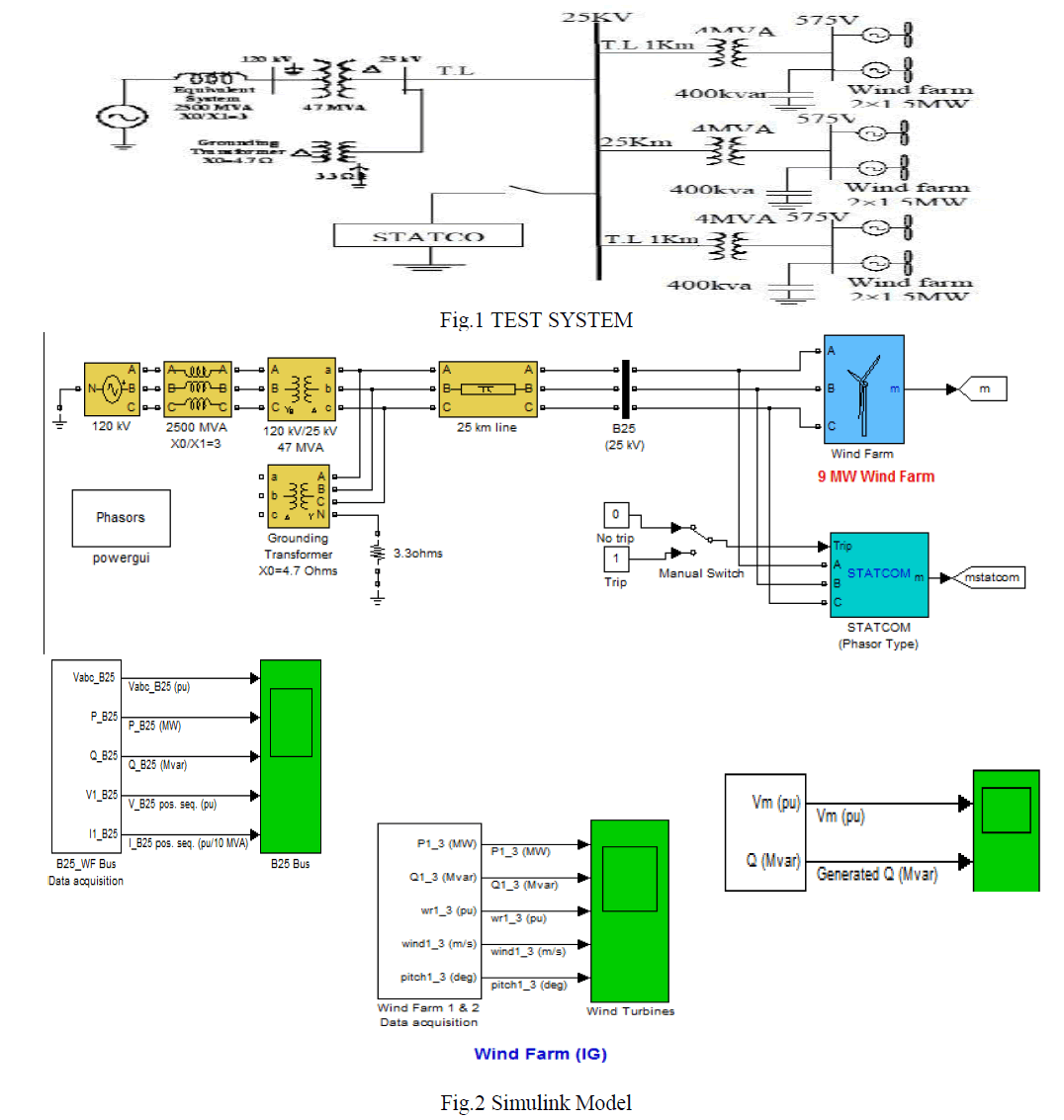 |
| The 9-MW wind farm is simulated by three pairs of 1.5 MW wind-turbines as shown in Fig. 2(a) & in Fig. 2(b).Wind turbines use squirrel-cage induction generators (IG) as shown in Fig. 2(a) & in Fig. 2(b). |
| Reactive power absorbed by the IGs is partly compensated by capacitor banks connected at each wind turbine low voltage bus (400 kvar for each pair of 1.5 MW turbine). The rest of reactive power required to maintain the 25-kV voltage at bus B25 close to 1 pu is provided by a 3-Mvar STATCOM with a 3% droop setting. |
| The stator winding is connected directly to the 60 Hz grid and the rotor is driven by a variable-pitch wind turbine. |
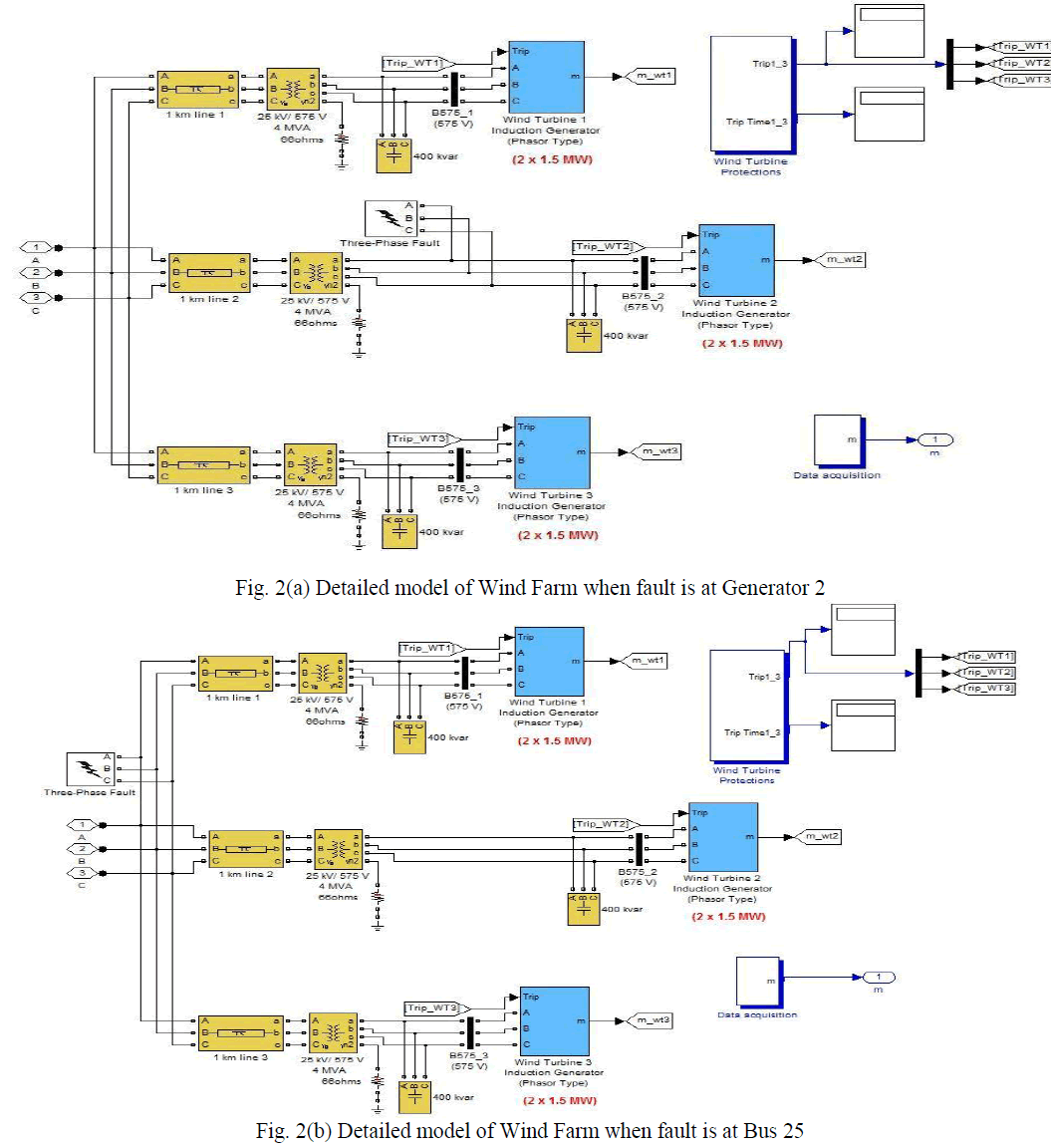 |
| The pitch angle is controlled in order to limit the generator output power at its nominal value for winds exceeding the nominal speed (9 m/s). |
| In order to generate power the IG speed must be slightly above the synchronous speed. Speed varies approximately between 1 pu at no load and 1.005 pu at full load. Each wind turbine has a protection system monitoring voltage, current and machine speed. As shown below: |
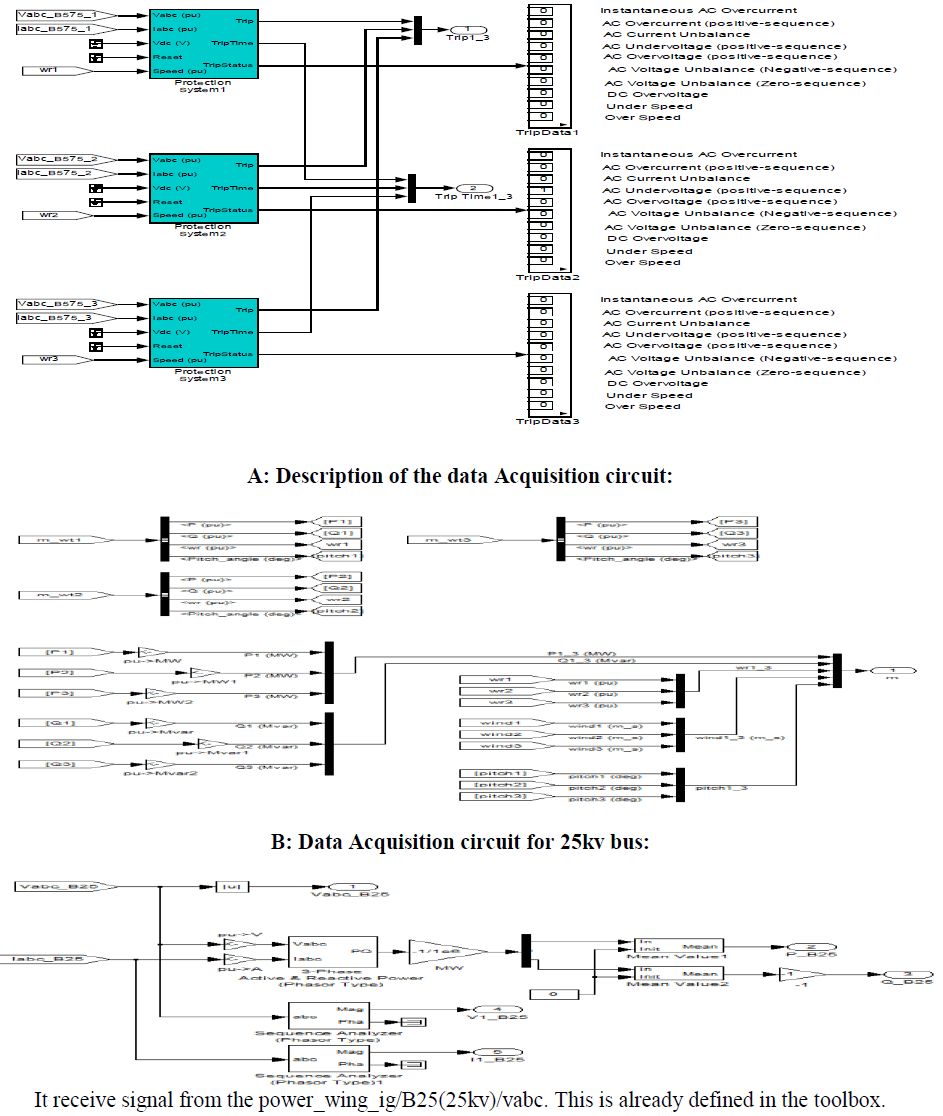 |
C: Data Acquisition circuit of the STATCOM: |
 |
| It receive signal from the power_wing_ig/goto1 i.e from the STATCOM which is already defined in the toolbox. |
D: Data Acquisition circuit of wind farm for wind turbine: |
 |
| In above circuit, input is taken from output of the data main acquisition circuit of the wind farm. |
III.RESPONSE OF THE SYSTEM WITH 3 MVAR STATCOM WHEN FAULT IS AT GENERATOR 2 at (3ms – 3.1ms) |
CASE 1: WITHOUT FAULT CONDITION |
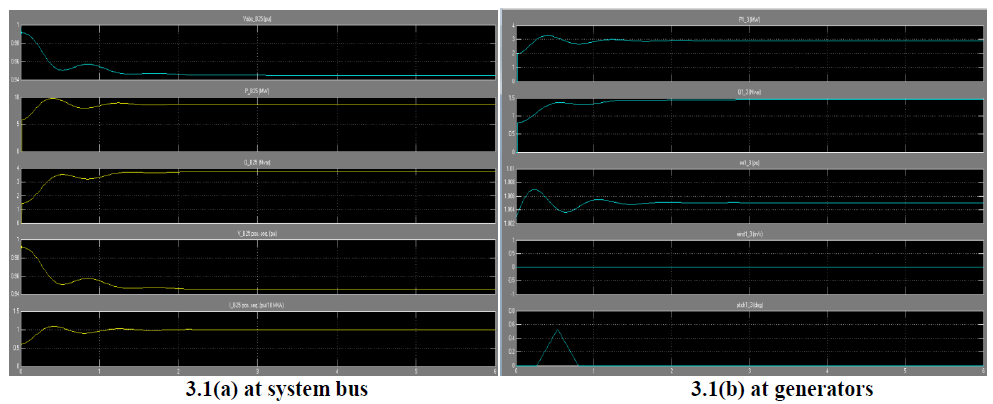 |
Fig.3.1. Response of the system without fault and without STATCOM |
| When the wind speed is set at 9m/s, then it is observed from Fig. 3.1(b) the output active power for each pair of turbine is 3MW, absorbed reactive power for each pair of turbine reaches 1.47Mvar, turbine speed for each pair of turbine reaches to 1.005pu as shown in Fig. 3.1(b). Because of the lack of reactive power support the voltage at bus 25kV now drops to 0.945pu as shown in Fig. 3.1(a). |
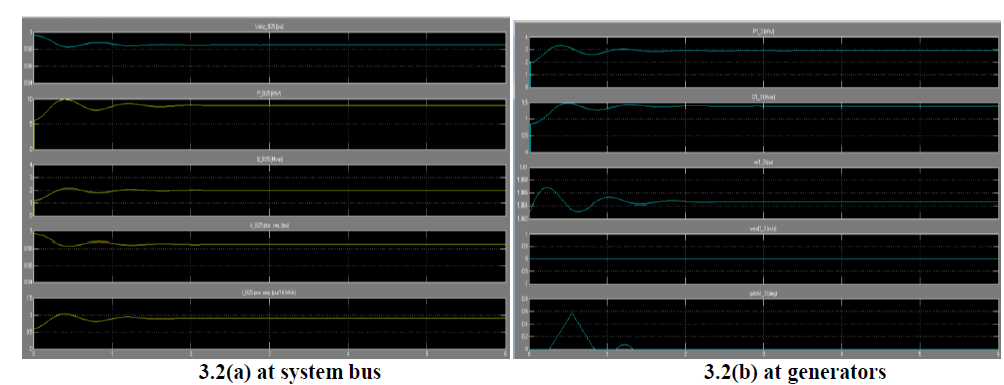 |
Fig.3.2. Response of the system without fault and with STATCOM |
| While with STATCOM the output active power for each pair of turbine is 3MW, absorbed reactive power for each pair of turbine reaches 1.47Mvar, turbine speed for each pair of turbine reaches to 1.0045pu as shown in Fig. 3.2(b). With respect bus 25 kV, voltage reaches to 0.985pu in Fig. 3.2(a), active power reaches to 8.9MW and absorbed reactive power is 2.08Mvar. |
CASE 2: PHASE TO PHAE TO GROUND FAULT CONDITION |
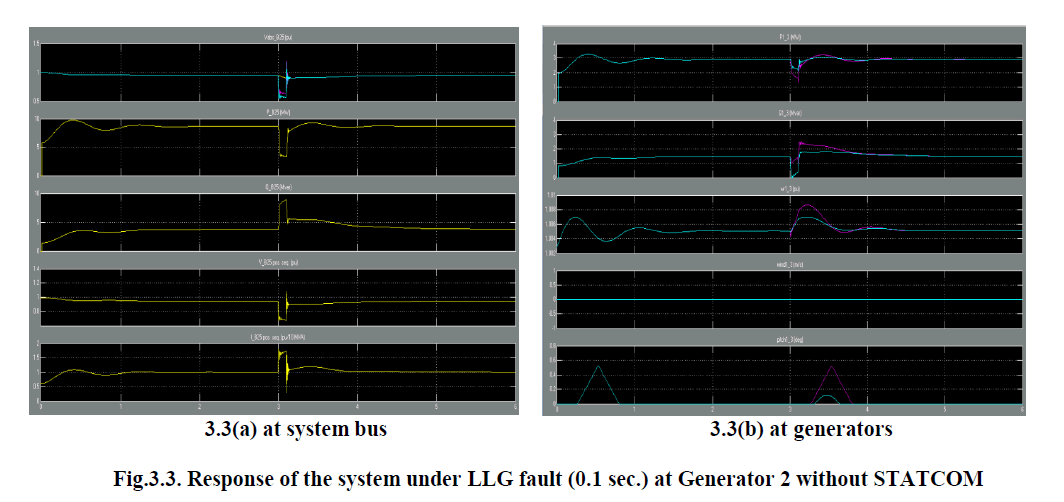 |
| Fig. 3.3 & Fig. 3.4 shows that the studied system is subjected to phase to phase to ground fault occurred at wind turbine 2 only and cleared after (0.1s) from 3 sec to 3.1 sec. It can be observed from Fig. 3.3(b) the output active power for each pair of turbine is 3MW, absorbed reactive power for each pair of turbine reaches to 1.47Mvar, turbine speed for each pair of turbine reaches to 1.005pu. Because of the lack of reactive power support the voltage at bus 25kV now drops to 0.95pu as shown in Fig. 3.3(a). While with STATCOM the output active power for each pair of wind turbine reaches to 3MW, absorbed reactive power for each pair of turbine reaches 1.47Mvar, turbine speed for each pair of turbine reaches to 1.0045pu as shown in Fig. 3.4(b). With respect bus 25 kV, voltage reaches to 1pu in Fig. 3.4(a), active power reaches to 9MW and absorbed reactive power reaches 2Mvar. |
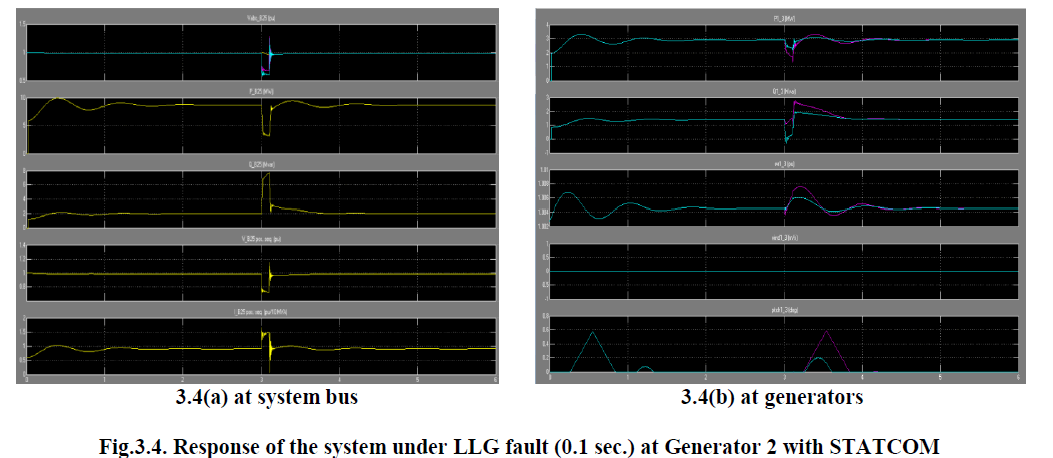 |
CASE 3: THREE PHASE FAULT CONDITION |
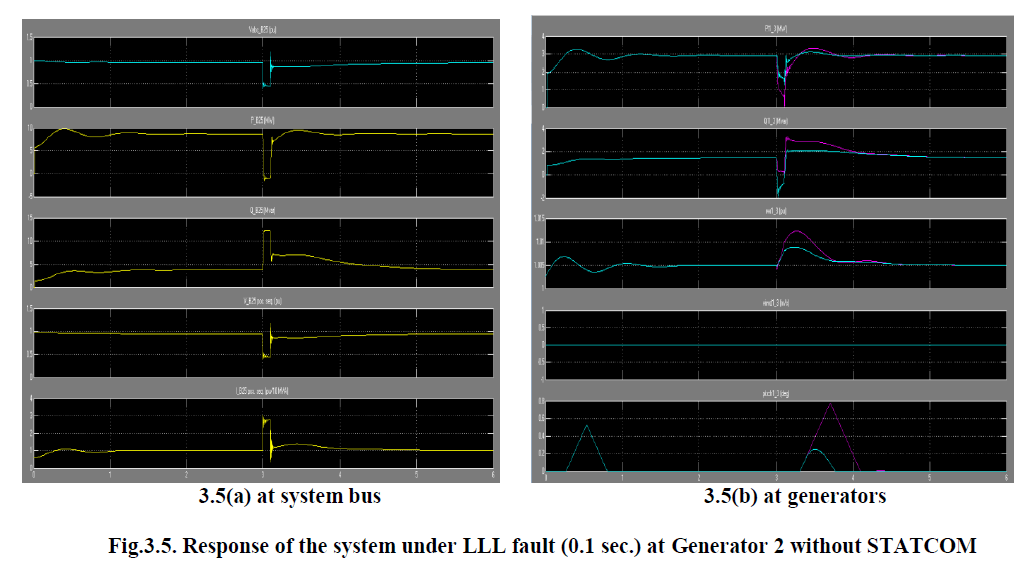 |
| Fig.3.5 & Fig.3.6 shows the studied system was subjected to three phase fault occurred at wind turbine 2 only and cleared after 100ms. Without STATCOM, it is clear that because of the lack of reactive power support the voltage at bus 25 kV, drops to 0.92pu. While with STATCOM the voltage at bus 25 kV, reaches to 1pu. |
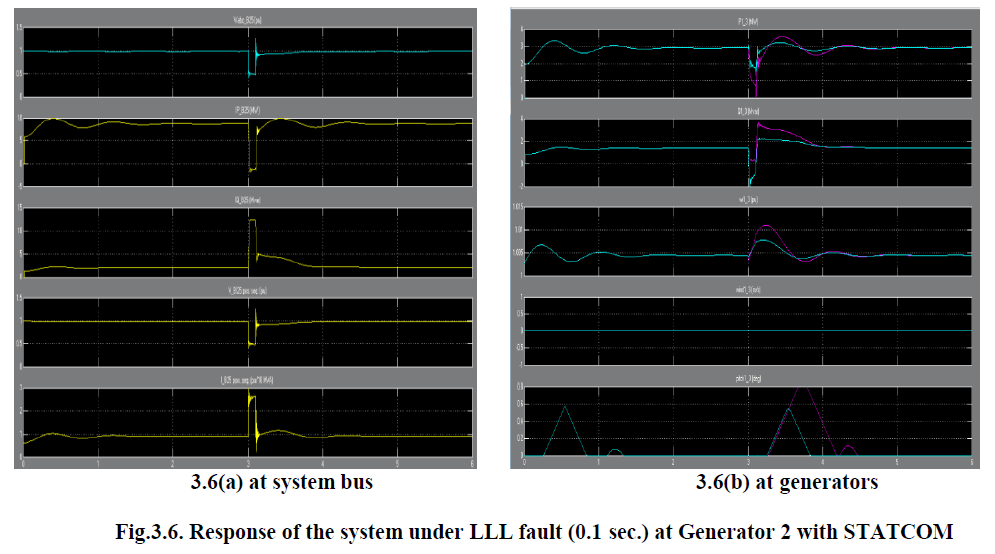 |
| In Fig. 3.3(b), Fig. 3.4(b), Fig. 3.5(b), Fig. 3.6(b) the waveform in pink colour shows the wind turbine 2 characteristics and the waveform in blue colour shows wind turbine 1 & wind turbine 3 characteristics as the fault is created at generator 2. |
IV.RESPONSE OF THE SYSTEM WITH 3 MVAR STATCOM WHEN FAULT IS AT BUS 25 at (3ms – 3.1 ms) CASE 2: PHASE-PHASE TO GROUND FAULT CONDITION |
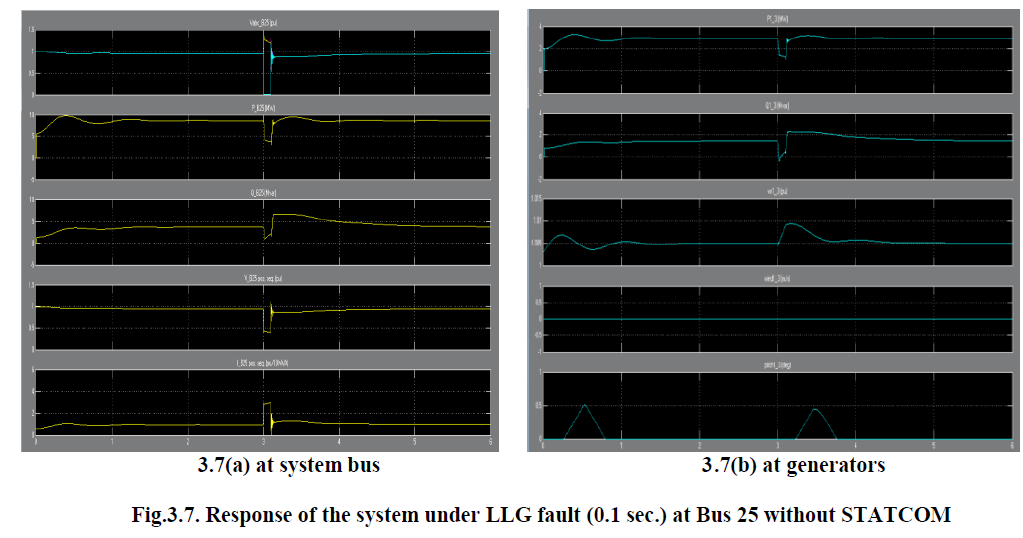 |
| Fig. 3.7 & Fig. 3.8 shows that the studied system is subjected to phase to phase to ground fault occurred at bus 25 and cleared after (0.1s) from 3 sec to 3.1 sec. It can be observed from Fig. 3.7(b) the output active power for each pair of turbine is 3MW, absorbed reactive power for each pair of turbine reaches to 1.47Mvar, turbine speed for each pair of turbine reaches to 1.005pu. Because of the lack of reactive power support the voltage at bus 25kV now drops to 0.95pu as shown in Fig. 3.7(a). While with STATCOM the output active power for each pair of wind turbine reaches to 3MW, absorbed reactive power for each pair of turbine reaches 1.47Mvar, turbine speed for each pair of turbine reaches to 1.0045pu as shown in Fig. 3.8(b). With respect bus 25 kV, voltage reaches to 1pu in Fig. 3.8(a), active power reaches to 9MW and absorbed reactive power reaches 2Mvar. |
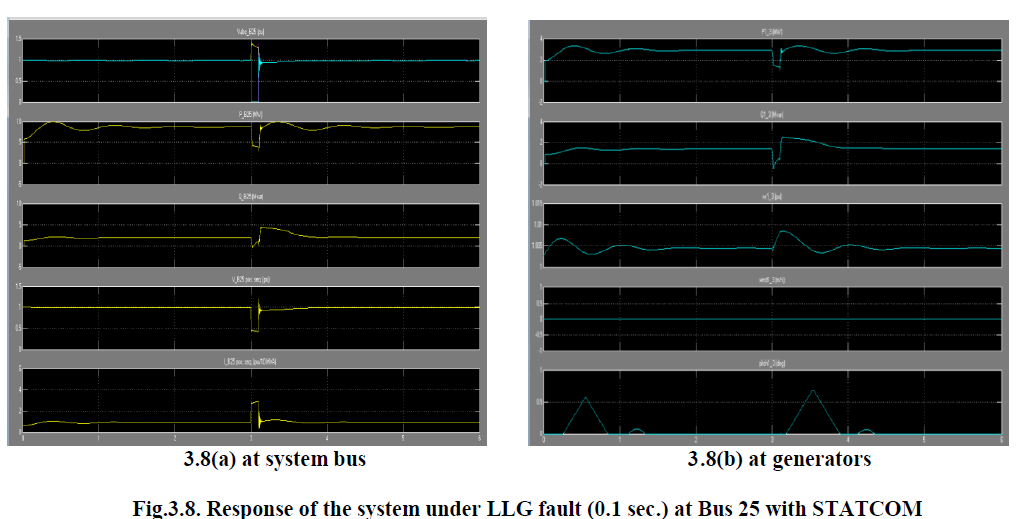 |
CASE 3: THREE PHASE FAULT CONDITION |
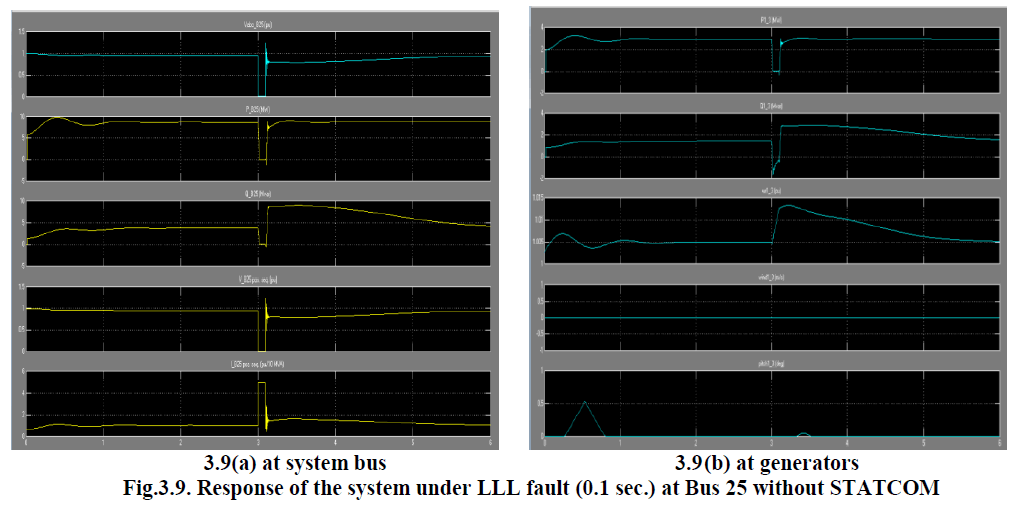 |
| Fig.3.9 & Fig.3.10 shows the studied system was subjected to three phase fault occurred at Bus 25 and cleared after 100ms. Without STATCOM, it is clear that because of the lack of reactive power support the voltage at bus 25 kV drops to 0.92pu as shown in Fig. 3.9(a). While with STATCOM the voltage at bus 25 kV, reaches to 1pu in Fig. 3.10(a). |
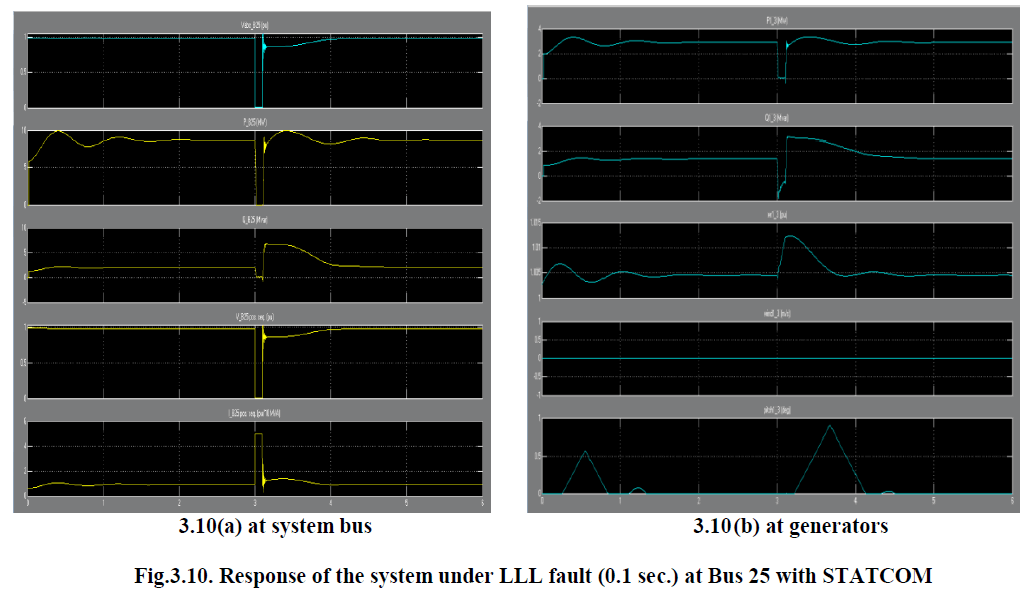 |
| In Fig. 3.7(b), Fig. 3.8(b), Fig. 3.9(b), Fig. 3.10(b) shows the same characteristics of waveform for wind turbine 1, wind turbine 2 & wind turbine 3 as the fault is created at bus 25. |
V.CONCLUSION |
| Power system with wind farms performance can be improved using FACTS devices such as STATCOM. The dynamic model of the studied power system is simulated using Simulink Matlab package software. |
| To validate the effect of the STATCOM controller of power system operation, the system is subjected to different disturbances such as faults and power operating conditions. The digital results prove the powerful of the proposed STATCOM controller in terms of Stability improvement, power swings damping, voltage regulation, and an increase of power transmission and chiefly as a supplier of controllable reactive power to accelerate voltage recovery after fault occurrence. |
References |
|